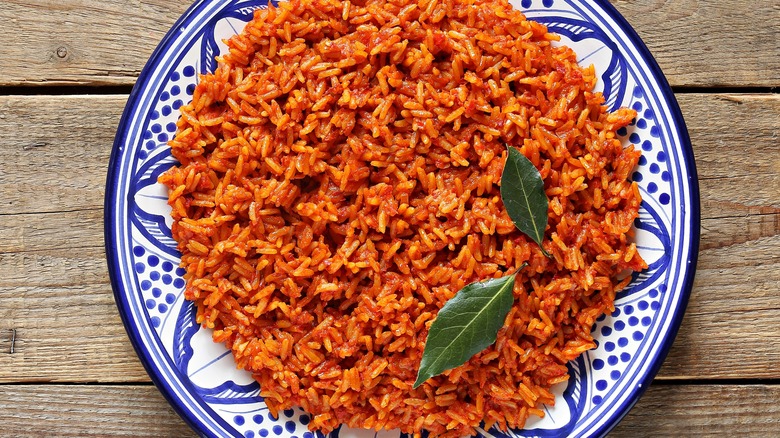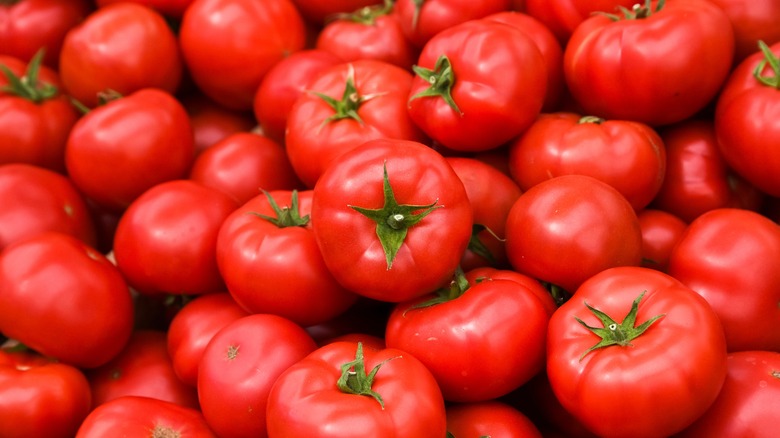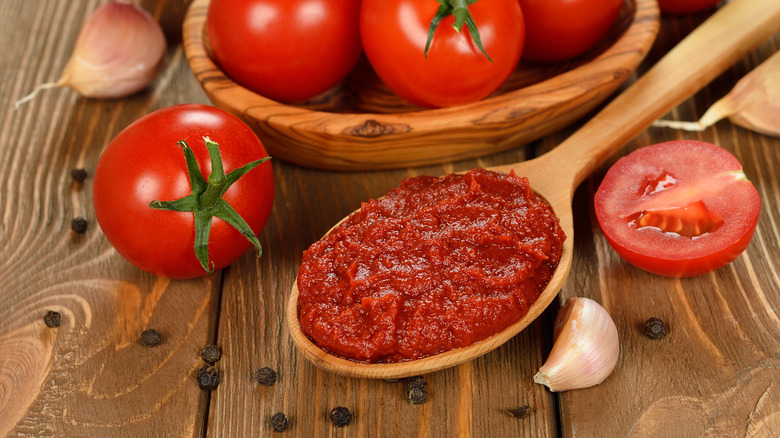Tomato Paste Is Essential For Vibrant Red Jollof Rice
It's not often that foods are expected to be a vibrant color, but there are at least two traditional dishes that pretty much must be vividly red: Indian tandoori chicken and West African jollof rice. It's not that either of these can't be utterly delicious otherwise, but we all know the weight of expectation and that old saw about the first bite being taken by the eye. While it's Kashmiri chilies that give tandoori chicken its flaming color, jollof rice depends on tomatoes — but if you really want to make it pop, be sure to use tomato paste and also give that paste enough time to cook to turn a lovely shade of brick red.
If you've yet to encounter jollof rice, it's a kind of pilaf made with long-grain rice, the aforementioned tomatoes, sweet as well as hot peppers, onions, stock, and often seafood — but, seeing how widely the dish has spread from its Senegalese roots, don't be surprised to encounter anything from beef to okra. (It's testament to how beloved the dish is that the word jollof has become Nigerian slang for fun.) So, how do you give your jollof rice its traditional red color without resorting to food coloring? One word: lycopene.
We're talking tomatoes, not werewolves
Lycopene is an organic molecule called a carotenoid that makes tomatoes red. It's related to beta-carotene, which gives us orange carrots. According to the NIH, it's a robust antioxidant, has anticancer properties, and supports cardiovascular health. As far as tomatoes are concerned, lycopene is there to make the fruit more attractive to animals — including us. To put it simply, red equals ripe (and green the opposite), and so tomato-eating critters like birds and people become unwitting helpmates in seed dispersion and therefore survival of the plant's species. Other foods which contain lycopene include watermelons, grapefruit, and apricots, to name a few.
Lycopene is red because of its peculiar molecular structure, which forces its electrons into a stable energetic state, only allowing them to absorb certain light frequencies, namely blue and green. Which light frequency is not absorbed and therefore reflected back into our eyes? You guessed it: red. By taking a few red, ripe tomatoes and turning them into a concentrated paste, you're also concentrating the lycopene.
The wonderful world of lycopene bioavailability
Jollof rice already contains tomatoes — and cayenne pepper as well as red bell peppers. Plenty of red, you might think. Not really; we're talking about hyper-red, not pink, after all, and even ripe tomatoes tend to water down the color. But tomato paste, which comes out of the tube as bright as paint, contains significantly higher levels of lycopene than raw tomatoes.
As you might imagine, something as concentrated as tomato paste in both flavor and color can tend to take over a dish if not used proportionally, but following recipe directions should see you through. Anyway, combining raw and concentrated tomatoes will extend and deepen their naturally sweet, tart flavors, giving your jollof rice a good structure and an added dose of umami. And don't forget, it's important to cook tomato paste for a little while to not only remove its raw taste, but also allow it to caramelize a little, deepening the flavor and that desired shade of red.


